Post-War Development of the Two Koreas
Post-War Development of the Two Koreas
This complete module with links to all materials may be downloaded as a PDF here.
Aaron Pickering
Oak Ridge High School
Oak Ridge, Tennessee
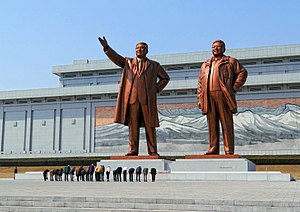
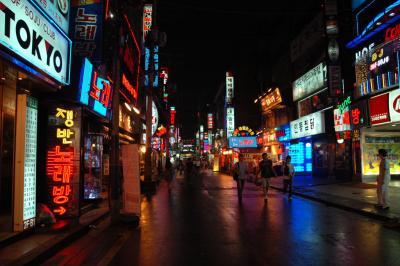
Top: The Mansu Hill Grand Monument statues of Kim Il-sung and Kim Jong-il in North Korea. Source: Wikipedia at https://tinyurl.com/ycg4xlhy.
Bottom: Seoul at night. Source: Flickr at https://tinyurl.com/y9oqr36s. Photo by lroderick7.
This module is designed for a standard high school world history course, although it could also be used in an AP world history, contemporary issues, or economics course. It primarily addresses Tennessee state social studies standard W.85—"Analyze the causes and effects of an increased role of South and East Asian countries in the global economy.” This module also aligns with several other Tennessee standards and advanced placement world history standards. However, the content and pedagogical strategies for the module are applicable for any high school teachers whose curricula include the development of East Asian states in the post-World War II era.
Estimated module length: Approximately three fifty-minute or two ninety-minute classes.
Overview
South Korea (The Republic of Korea) and North Korea (The Democratic People’s Republic of Korea) provide the clearest and most compelling example for students to understand the stark contrasts between a largely free market economy and democratic nation, and that of a command economy dominated by Communists. Japan’s colonial occupation of the Korean peninsula for nearly four decades laid the foundation for industrialization, but it also failed to produce meaningful economic or political gains for the Korean people. Foreign rivalries also fueled the war that divided the peninsula and established two different ideologies for North and South. South Korea experienced widespread government corruption and limited growth from the end of the 1950–1953 Korean Conflict until the early 1960s, despite massive U.S. aid. The South then experienced a military coup and decades of political suppression but increasing economic freedom before it became the success story of recent decades. North Korea had numerous economic advantages over the South in the early postwar days. Its embrace of Communism and a strict command economy, however, produced an unsustainable model. In 2017, South Korea’s GDP (adjusted for purchasing power parity) ranked fourteenth in the world. North Korea’s regime leaves the majority of its people in poverty and darkness.
Objectives
Students will:
Recognize the conditions and events leading to the split and war between North Korea and South Korea.
Analyze economic and demographic data to illustrate the contrasting Korean economies over time.
Compare the political and economic systems of South Korea, differentiating among the Rhee regime, the Park regime, and subsequent governments.
Explain the rationales behind North Korea’s policies of self-reliance (Juche) and militarization, as well as the resulting standard of living.
Create a summary document illustrating the political and economic contrasts between North Korea and South Korea.
Prerequisite knowledge
Students should have a basic understanding of the contrasts between democratic and Communist political systems, as well as the contrasts between market and command economies. Basic background knowledge about the U.S.–USSR Cold War rivalry, especially in Asia, and the concepts of containment and proxy wars is also helpful. Students are not expected to have basic knowledge of the Korean peninsula’s history.
Module introduction
Perceptions of Korea and an overview of Korea’s modern history
Estimated time: thirty minutes
Although most students will have a limited background in Korean history, both North Korea and South Korea play many roles in the popular American consciousness. To establish the relevance of the topic, lead a brainstorming activity and a short diagnostic assessment with the students, situating Korea in East Asian geography and history, as well as drawing out popular concepts of Korea that are sharply contrasting between North and South.
Write “Korea” in the middle of the board or display workspace. Ask students to volunteer the first things that come to their minds when they think of Korea. Record the responses around the board in a randomized pattern. After gathering a good list with, I hope, at least some items representing both Koreas, ask students to categorize the items into those that fit with South Korea and those that fit with North Korea. Briefly discuss why the students mentioned these concepts and why they associate these with each of the Koreas.
Students’ responses on South Korea will often include consumer product brands like Samsung, LG, Hyundai, Kia, popular culture references (such as professional video gaming leagues and the K-pop music genre), the 2018 Winter Olympics, and high-technology references like high internet speed. Typically, students have less knowledge of North Korea, although recent events could include nuclear weapons, Kim Jong-un, references to escalating tensions with President Donald Trump and the United States, Communism, famine, poverty, and lack of political freedom.
Author’s comments on student reactions
The students, after a short warmup, were enthusiastic and helped fill the board with items for both North and South Korea. There was nothing too far out of the expected range of responses, and the students did well at explaining why their perceptions fit either North, South, or both. My one surprise was that students did not mention any major South Korean consumer product companies (after some prompting, I was able to elicit “Samsung” from a German exchange student in the second section). Despite the students’ familiarity with major companies, the general assumption was that the electronics and automobile manufactures were Japanese rather than South Korean when I asked them. The students had clearly discussed the oppressive regime in North Korea in a previous government course, but they indicated they had little to no formal coverage of South Korea.
Display a blank map of East Asia. Have students place the following nations on the map and draw the borders of each nation on the blank map:
China
Japan
North Korea
South Korea
Việt Nam
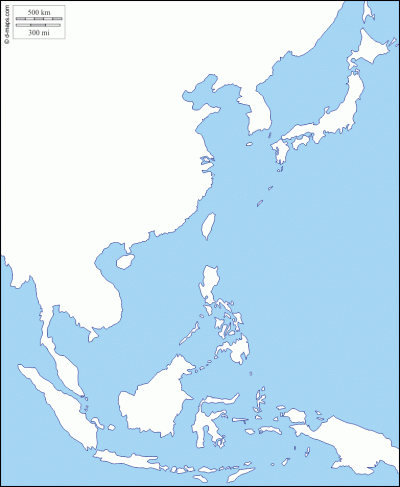
Blank map of East Asia. Source: D-Maps at https://tinyurl.com/yclx3uh8.
Then, have students finish this short diagnostic test.
Asia diagnostic test
For the following questions, please choose from the following countries and write your answer(s) in the space provided:
China
Japan
North Korea
South Korea
Viá»t Nam
Which of these nations has the largest standing army? (China)
Which of these nations has the second-largest standing army? (North Korea)
Which of these nations has the largest gross domestic product (GDP) per capita? (Japan)
Which of these nations has the second-highest GDP per capita? (South Korea)
Which of these nations has the largest population? (China)
Which of these nations has the second-largest population? (Japan)
Which of these nations has the most land area? (China)
Which of these nations has the second-most land area? (Japan)
Which two of these nations have multiparty democratic governments? (Japan and South Korea)
Which three of these nations have single-party Communist governments? (China, North Korea, and Viá»t Nam)
Show a political map of East Asia and have students compare their maps to the real map. Reveal the answers to the questions and briefly discuss studentsâ successes and misconceptions.

Political map key of East Asia. Source: D-Maps at: https://tinyurl.com/y7v7rgkf.
Display the below nighttime satellite image of the Korean peninsula from National Geographic. Ask students about the contrast between North and South Korea. How does this image confirm or change the students’ preconceptions about the two Koreas discussed at the beginning of the lesson?
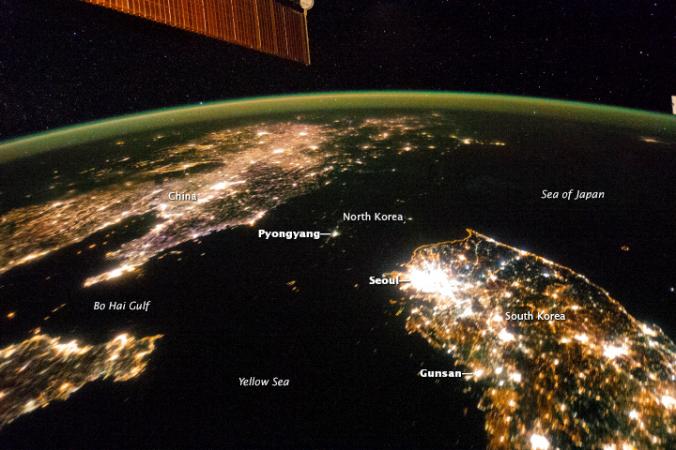
North and South Korea at night. Source: National Geographic at https://tinyurl.com/y7p8j8f5.
Present a basic historical background for students using this three minute, forty-eight second long video clip from The Daily Conversation: “The Modern History of North Korea.”
Debrief students on the video by questioning and recapping key historic developments: Japanese occupation, World War II liberation, Cold War division and ideologies, combatants and course of the Korean War, Kim regime’s cult of personality, North Korean military-first policy, isolation following fall of Soviet Union, and North Korea’s current relationship with China.
Data analysis: Comparing the Koreas’ demographics and economies over time
Estimated time: thirty minutes
The development of the postwar Koreas is highly divergent. Although initially the North had some developmental advantages, the South Korean economy grew tremendously starting in the 1960s. Show students this comparison of the two Koreas’ income per person from 1900 to the present day from Gapminder.
Based on the background from the introductory video, ask students why the nations’ incomes fluctuate at various points on the timeline. Key events include industrial development in 1910–1945 when Korea was a colony of the Japanese empire,, suffering during liberation after World War II, setbacks during the Korean War, stagnation in the South during the First Republic, growth during the Park regime (addressed in the next activity), and famine and poverty in the North following the fall of the USSR.
If students have access to computing resources and attendant skills, ask them to graph some other demographic criteria comparing the two Koreas over time using Gapminder.org (an outstanding tool for exploring and drawing conclusions in a history or geography course). Demonstrate how to use the title area of the graph linked above to explore other categories of data. Based on their own explorations, ask students to share which other criteria reveal important contrasts between the two Koreas. Although you may wish to warn students that many categories lack reliable or complete data on North Korea, many demographic categories demonstrate the contrasting histories of the two. If students do not discover it on their own, the categories for energy usage are particularly relevant given the nighttime satellite image of the peninsula shown earlier.
As a summary, or if computing resources are not readily available, show students The Guardian’s “Datablog” summarizing key demographic contrasts between the Koreas as of 2013

North Korea vs. South Korea. Source: The Guardian (with data from the CIA World Factbook, Reporters Without Border, The World Bank, Foreign Policy, and IISS Military Balance 2012) at https://tinyurl.com/ya4sdv23.
South Korea’s journey to becoming a market-based economic powerhouse
Estimated time: forty-five minutes
Although South Korea is an economic powerhouse with a democratic government today, postwar South Korea went through difficult changes in both its economic and political systems. To characterize some of these changes, have groups of students become “experts” on different periods of South Korean history and share their results with the class. This jigsaw-style activity allows the summation of a great deal of content while still exposing students to in-depth secondary historical texts and asking them for analysis.
Break students into four groups. Each group will read excerpts from articles on Korean history and create a list of annotated events. It may be helpful to display the graph from Gapminder.org demonstrating the GDP per capita of the two Koreas while students are reading to reinforce the text with the data they explored in the previous section.
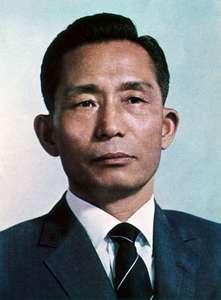
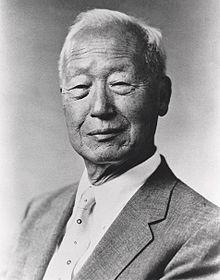
Syngman Rhee (left) and (right). Source: Wikipedia and Encyclopedia Britannica at https://tinyurl.com/q2gg643 and https://tinyurl.com/ycqjbxg7.
The Rhee Regime, 1948â1960: Excerpts from Michael J. Sethâs âAn Unpromising Recoveryâ
Have each group make a list addressing the five most important events of the era. Each event should include an annotation explaining one of two questions: How did the policies of the South Korean government change during your period? How did these changes affect the South Korean economy? Have students cite specific supporting text for each point. You may wish to illustrate an appropriate annotation using the Korean War as a starting point. When the groups have completed their work, bring the lists together on the board or display and have representatives from each group present their sections.
North Koreaâs militarism, nuclear ambitions, and foreign relations
Estimated time: forty-five minutes
After the fall of the Soviet Union and the loss of its support, North Korea has come to rely more on its own resources and military strength. While China does still provide support to the North Korean regime, North Koreaâs extreme militarism and nuclear weapon ambitions have increased its isolation. With the inauguration of President Donald Trump, the relationship between North Korea and the United States, its traditional enemy, has seemingly improved, though tensions remain high.
In order to understand more about North Koreaâs militarism and nuclear ambitions, show students the six minute, forty-eight second long video âThe Growing North Korean Nuclear Threat, Explainedâ from Vox Media:
Have students answer the following questions:
Although North Korea has had nuclear weapons since 2006, why did their development of a working ICBM in 2017 change the strategic situation?
Why does the Hwasong-14 ICBM test not necessarily place the United States in danger of a North Korean nuclear attack?
What caused North Korea to accelerate its nuclear weapons development in the early 1990s?
Why did the North Korean regime believe that this was necessary?
If North Korea develops the ability to strike the United States with nuclear weapons, what does the author of the video believe could happen to South Korea and Japan? Why?
Why does President Trump see negotiations with China as key to addressing the North Korean nuclear issue?
How does the North Korean regime maintain such strong military spending while the standard of living for its citizens remains so low? Does the cult of personality surrounding its leaders and propaganda play a central role in this process?
Debrief students and discuss their responses.
Have students analyze the pieces of North Korean propaganda in this gallery from The Guardian and more recent posters portraying President Trump from Reuters. Answer the accompanying questions. You may wish to utilize smaller groups to help generate more participation and have them share their conclusions with the full class.
How is the United States portrayed in these images?
What images are used to express North Korean strength?
Why do these images portray President Trump as a dog? What do the texts accompanying these images imply about President Trump?
How do these images appeal to the North Korean people? Why might they embrace the messages conveyed in these pieces?
Discuss student answers with the entire class and follow up with two more general questions:
To what extent does the North Korean regimeâs propaganda require that open access to media be restricted?
Can propaganda be effective in open societies?
References and resources
www.d-maps.com: D-Maps features a series of excellent maps of Asia that are used in this module.
https://news.nationalgeographic.com/news/2014/02/140226-north-korea-satellite-photos-darkness-energy/: These satellite images from a National Geographic article show both North and South Korea at night.
https://www.youtube.com/watch?v=v70-fi6PPU0: This is a link to âThe History of North Koreaâ video from The Daily Conversation on YouTube.
https://www.gapminder.org/tools/#_state_time_startOrigin=1900&delay:100;&entities_show_geo_$in@=prk&=kor;;;;&marker_axis/_x_zoomedMin=1900;;;&chart-type=linechart: This graph compares the GDP per capita of North and South Korea from 1900 through 2018.
https://www.theguardian.com/world/datablog/2013/apr/08/south-korea-v-north-korea-compared: This chart from The Guardian depicts various statistical differences between North and South Korea.
https://www.asianstudies.org/publications/eaa/archives/an-unpromising-recovery-south-koreas-post-korean-war-economic-development-1953-1961/: Michael J. Seth, âAn Unpromising Recovery: South Koreaâs Post-Korean War Economic Development: 1953â1961,â Education About Asia 18, no. 3 (2013): 42â45.
https://www.fpri.org/article/2017/04/nations-prosper-case-north-south-korea/: Lucien Ellington and Tawni Hunt Ferrarini, âWhy Do Some Nations Prosper? The Case of North and South Korea,â Foreign Policy Research Institute, April 26, 2017.
https://www.asianstudies.org/publications/eaa/archives/tigers-hard-workers-and-online-gamers-south-koreas-political-economy-since-1980/: Joel R. Campbell, âTigers, Hard Workers, and Online Gamers: South Koreaâs Political Economy Since 1980,â Education About Asia 18, no. 3 (2013): 49â52.
https://www.youtube.com/watch?v=NwbYpdGpx8U: This is a link to âThe Growing North Korean Nuclear Threat, Explainedâ video by Vox on YouTube.
Propaganda art from North Korea from both The Guardian and Reuters can be found at
https://www.theguardian.com/world/gallery/2017/aug/20/north-koreas-propaganda-art-in-pictures and https://www.reuters.com/article/us-northkorea-missiles-propaganda/mad-dog-anti-trump-leaflets-suspected-floated-in-from-north-korea-turn-up-in-seoul-idUSKBN1CL15P